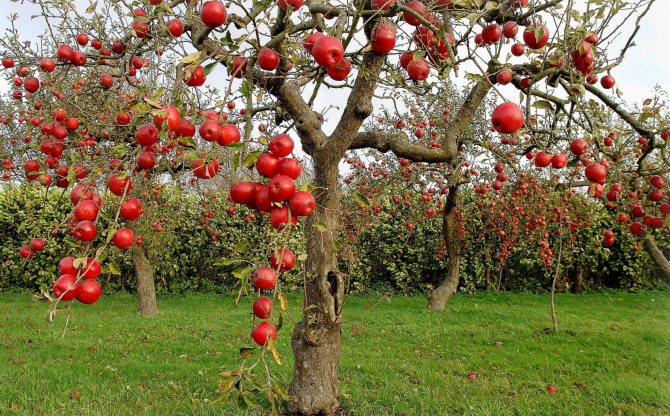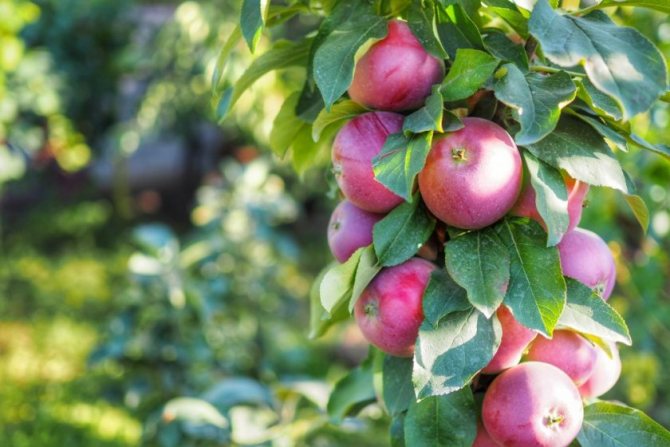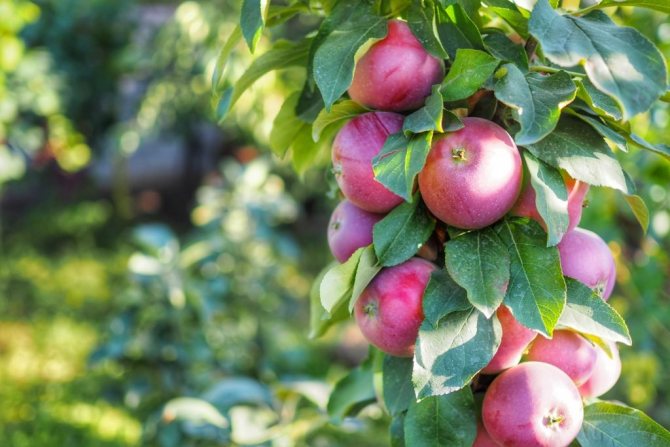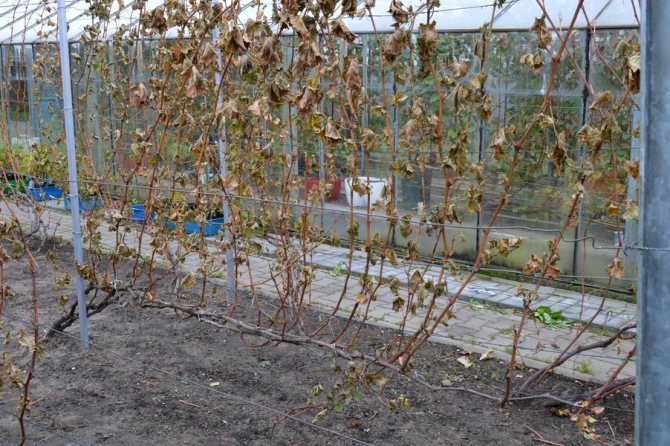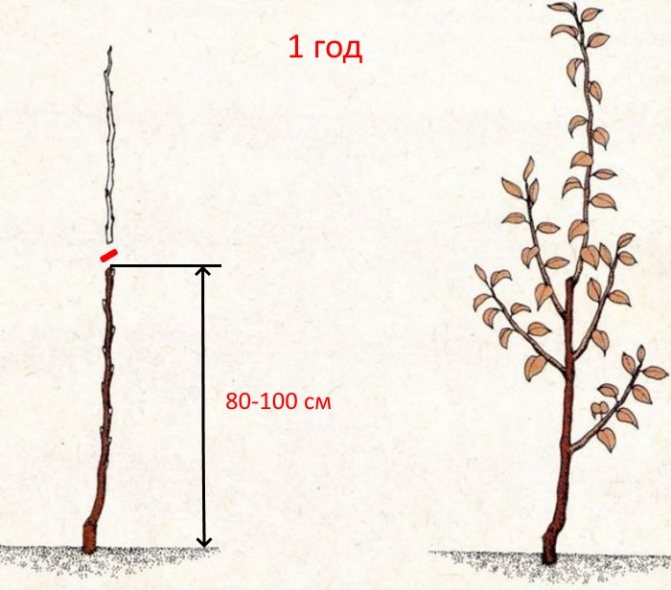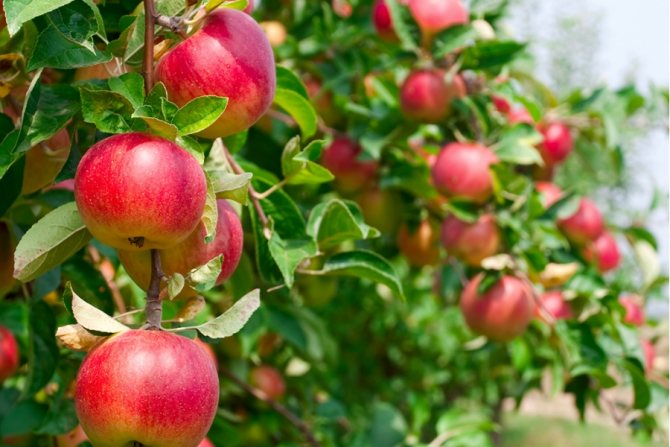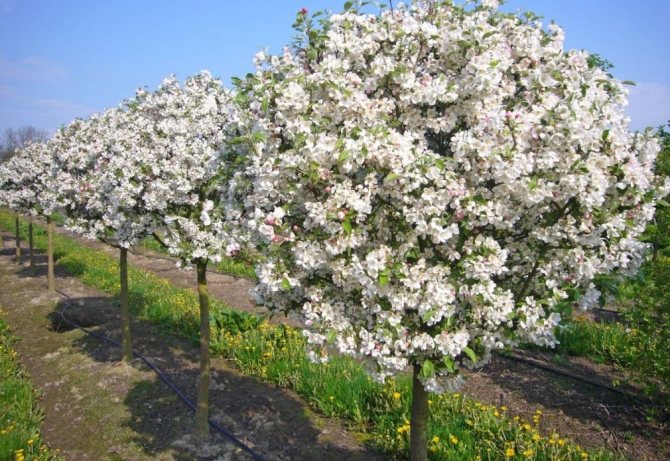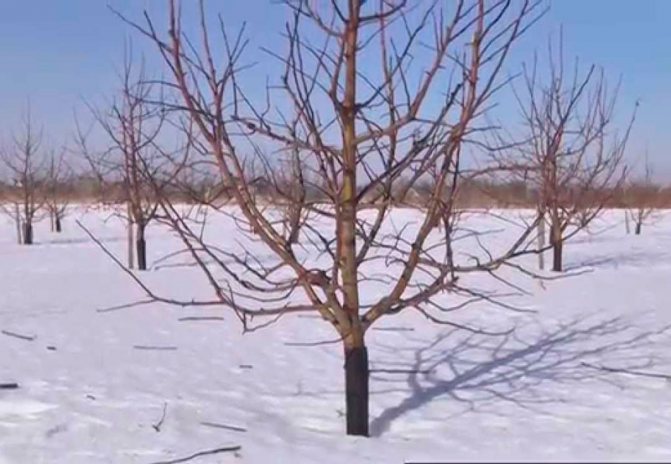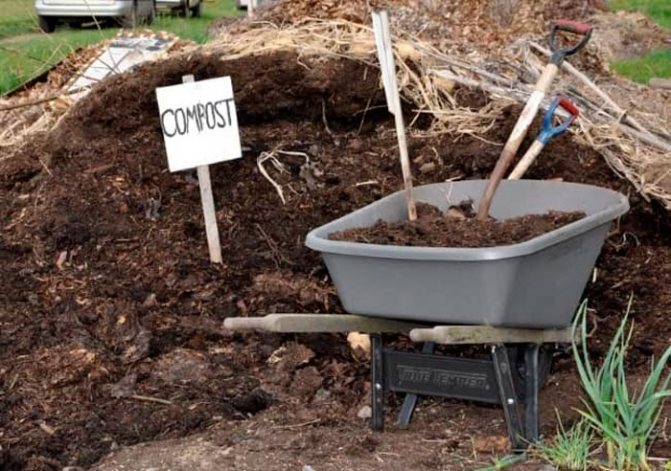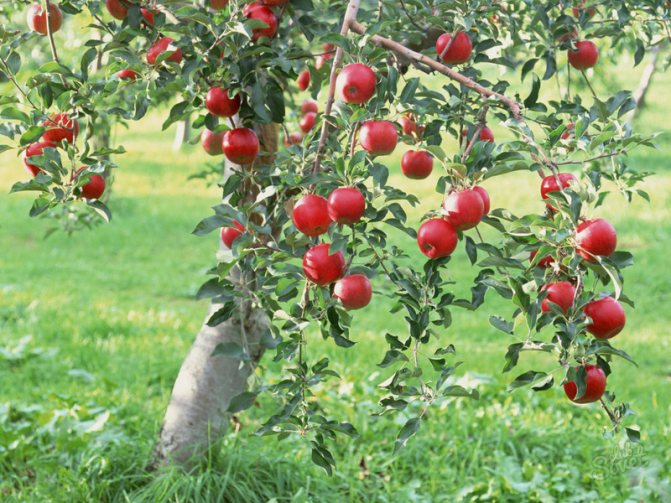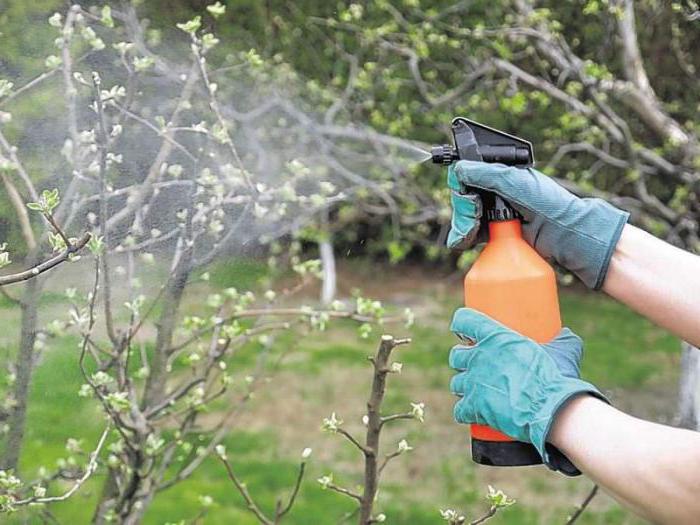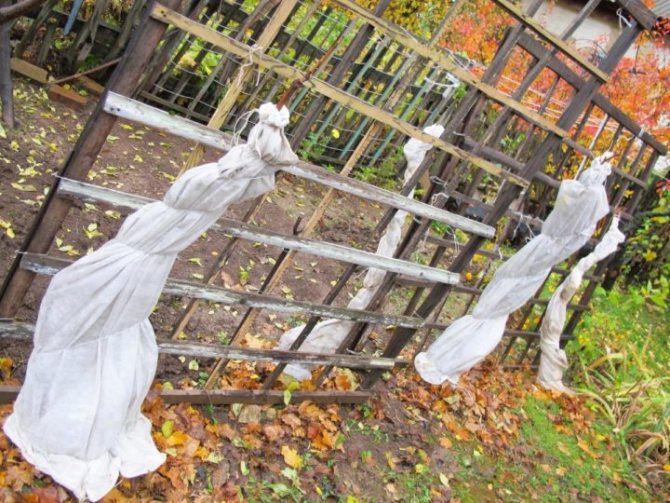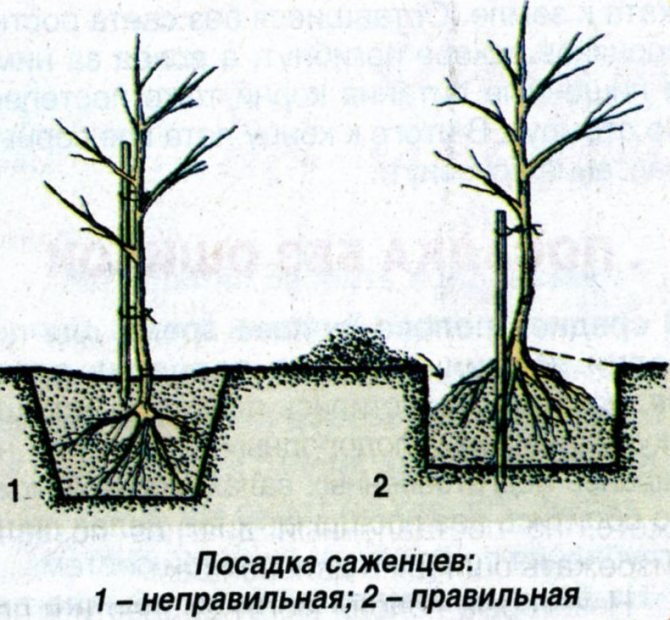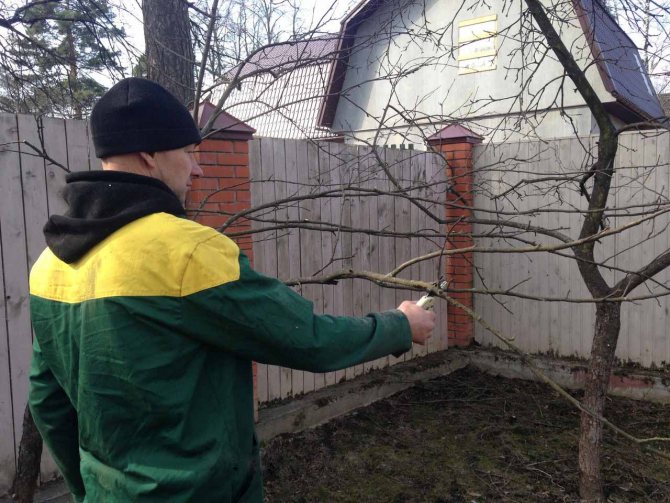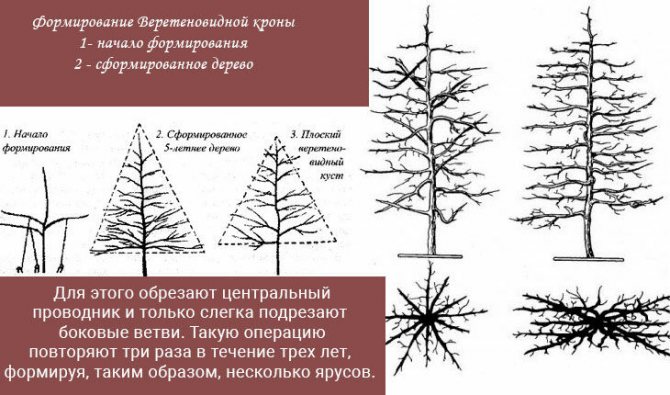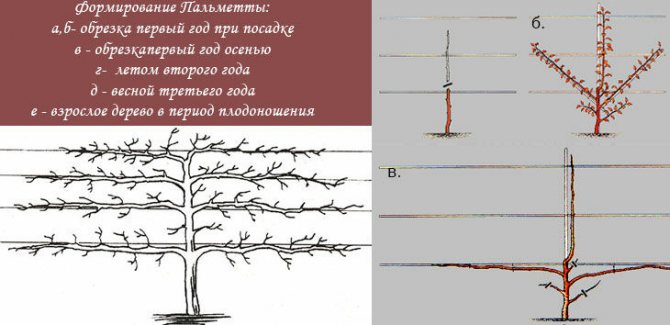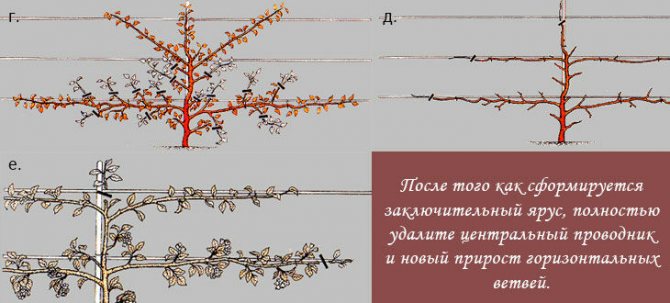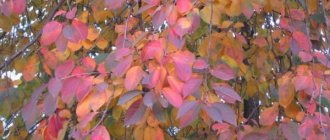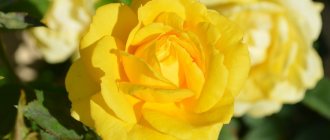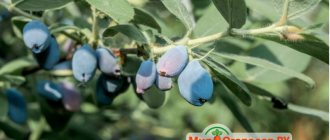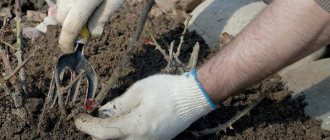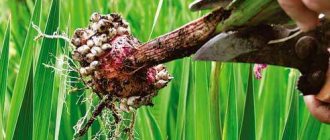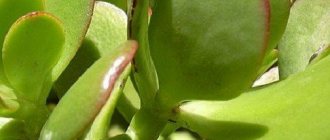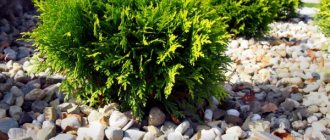Gardening »Apple tree
0
396
Article rating
Compared to the classic apple trees, reaching a height of about 6-8 m and having a crown with a diameter of about 10 m, varieties growing in columns can significantly reduce the garden area due to the peculiarities of growth. Regular pruning of columnar apple trees allows you to ensure the correct development of the fruit crop and get a decent harvest.
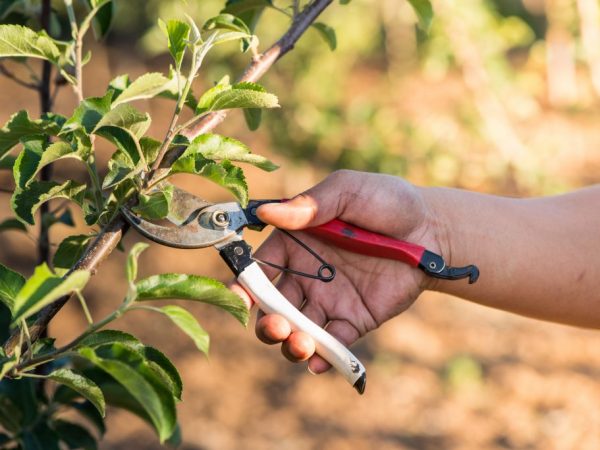
Rules for pruning columnar apple trees
Description and characteristics of the variety
Columnar varieties of apple trees often began to be found in the gardens. They take up little space and decorate the site. A characteristic feature is the presence of one trunk, from which short, thick shoots extend. Fruits are formed both on the lateral branches and on the central trunk.
Distinctive features of columnar apple trees:
- Most trees grow no more than 3 meters in height, but there are specimens that grow up to 5 meters.
- Almost all varieties of apple trees do not tolerate cold winters. If the crown kidney is damaged, the development of culture changes. The shape of the crown and the taste of the fruit change.
- The compactness of the culture allows you to plant it in an area where there is little space.
- Fruiting begins two years after planting.
- The roots are close to the surface of the earth.
- High productivity.


It is easy to care for columnar apple trees, but there are also some distinctive features:
- the root system of columnar apple trees spreads close to the surface of the earth, therefore frequent watering is required;
- high demands on feeding;
- it is impossible to loosen and weed the soil around the trunk;
- it is recommended to plant a lawn near the trunk, which will retain moisture and heat.
The disadvantage of a columnar culture is a relatively short growing season. After 12 years, it ceases to bear fruit.
Pruning apple trees at 3 years old
When you reach three years of age, you do not need to prune too much young trees. In addition, it is necessary to add new skeletal branches. If the central trunk grows too quickly, it must be restrained by pinching or lightly trimming the crown.
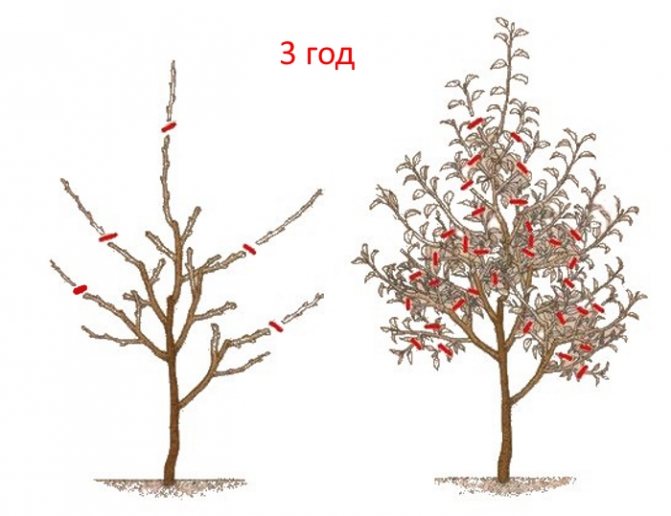

Cutting the center conductor and side branches by 20 cm
Why do you need to prune
To understand whether it is necessary to prune a columnar apple tree, it is important to understand the growth features of this culture.
The main part of the columnar apple is the kidney apex. If it is not frozen or damaged, the branches of the tree will grow short and the tree will look compact. There is no need for pruning.
The cause of kidney loss is frost, improper fertilization. Sometimes gardeners cut off the top by mistake. In this case, the rapid growth of lateral shoots begins, and in order to save the crop, pruning is carried out.
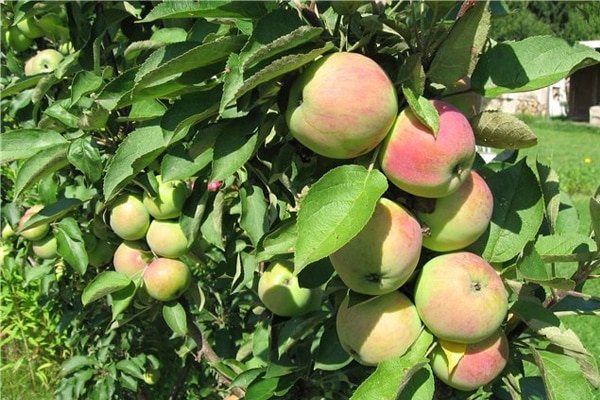

The formation procedure has many positive aspects:
- the correct shape of the apple tree is formed;
- the likelihood of branches tangling is excluded;
- young branches grow and develop well;
- there is a rejuvenation of the fruit crop;
- the number of crops increases and the quality of fruits improves;
- the appearance of the culture is improved.
In order for all these points to be realized, it is necessary to carry out pruning correctly.
In addition to proper formation, care consists in regular watering, timely fertilization and treatment from pests and diseases.
If you need to rejuvenate a dwarf apple tree
European gardeners have developed their own pruning system, which helps to restore even very neglected plants - this is a renewal system. The technique is complicated only at first glance. The main thing is to take into account the main characteristics of the culture and focus on reducing the share of annual growth. The stepsons should be shortened by about one third, cut off the smaller half. On the weakest tree, only the top can be cut off. Spread the fruits and twigs well along the length of the branch - so the fruits will definitely not be cramped. Reduce the number of stepchildren to the maximum, not forgetting that their total number should correspond to the variety and growth rate of the apple tree. Ideally, only one leading (central) branch is left for the fruit tree - two leaders weaken the plant.


In early September, rejuvenation is usually not carried out.
When to start pruning an apple tree
The timing for each apple variety is individual. For early summer varieties, the fall months are the recommended times. Apple trees with medium ripening are recommended to be pruned in winter. Late varieties are best formed in spring.
You need to form the crown correctly. Usually in each season, the procedure is carried out with one specific purpose:
- The main one is pruning during the winter months. The most successful time for the procedure is the end of winter.
- Spring pruning is done to determine the main trunk. The procedure is best done after flowering.
- In the summer months, unnecessary branches are removed.
- In the autumn, thickened sections of the crown are thinned out, removing strong vertical branches.
See also
Description and characteristics of the apple variety Autumn joy, cultivation and productivityRead
Pruning is carried out at any time of the year, starting from the second year after planting the seedling.
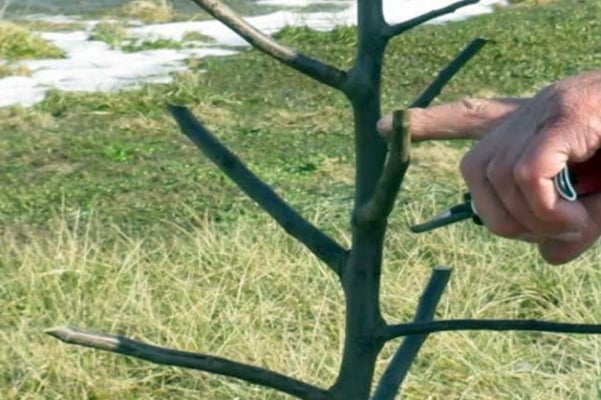

Basic terms
To understand the process of pruning dwarf apple trees, a novice gardener should familiarize himself with the existing terminology:
- a shoot that grows during the year is called an annual one;
- branches growing from the trunk are considered to be branches of the first order, shoots growing from them are considered to be branches of the second order;
- an escape, which is an extension of the trunk, acts as a leader;
- twigs that have sprouted during the summer - growth;
- fruiting branches on which the crop is formed are called overgrown;
- next to the growth of the central shoot, a lateral shoot can grow, it received the name of a competitor;
- flowers are formed from flower buds, and shoots develop from growth buds.
What tools will be needed
The formation of a columnar apple tree is carried out with well-sharpened garden tools. To trim the crown, you need to prepare a disinfectant:
- a sharp knife is useful for removing very thin branches and burrs;
- thin branches are removed with pruning shears;
- to remove the upper branches, you will need a pruner with long handles;
- stairs.
The cut site is immediately treated with disinfectants, which are applied with a brush. Garden var, garden acrylic paint, Bordeaux liquid are suitable. Solutions are made on the basis of components such as copper sulfate, potassium permanganate.
Features of columnar apple trees
These varieties were obtained in the 80s of the last century as a result of an accidental mutation of one of the oldest apple trees in Canada. Trees could not fail to interest many amateur gardeners.
In addition, fruits are formed both on short fruit branches and directly on the main trunk.


Columnar apple trees are usually also characterized by a small height, but this value is largely determined by the characteristics of the stock onto which the trees were grafted. If the stock turns out to be vigorous, then it is possible to grow a "column" up to 4-5 meters in height and even more.
There is one more point that is rarely paid attention to. Many varieties of columnar apple trees were bred for much milder climatic conditions than are available in most of Russia. It is for this reason that the apical buds of these trees often freeze, not withstanding severe frosts. Namely, they are the most valuable buds, the dying off of which can completely alter the development of the tree.


Finally, the columnar apple tree has a shallow root system, so it requires more frequent watering, especially in hot and dry weather. It is impossible to loosen and dig up the earth in its near-trunk circle for the same reason. Most often, it is sown with special lawn grass to maximize moisture retention.
All these features cannot but affect the nature of the care and pruning, which a columnar apple tree may need.
Schemes and forms of correct trimming
The pruning of the pyramidal apple tree is not carried out strongly and does not involve the main shoot. Side horizontal and vertical branches should be formed. It is on them that the harvest ripens.
Pruning branches is carried out in two directions:
- part of the shoot is cut off;
- in the second option, the branch is cut off completely.
The vertical branch grows stronger and faster. The horizontally located shoots grow more slowly, but they have more flower buds, this feature was the basis of the pruning procedure.
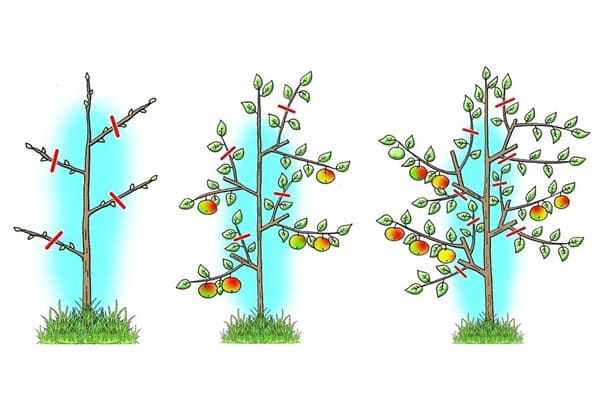

To form a beautiful crown and increase yields, you will need to wait 5 years. The general scheme for pruning a tree, which will be within the power of novice gardeners, involves the following steps:
- some time after planting, the trunk is shortened and the lateral shoots are removed, it is better to carry out the work in early spring before the juices begin to move (in the first year of growth, it is better to cut off all the lateral shoots so that two buds remain on each);
- the next year, the central trunk is not touched, and the lateral shoots are shortened to a length of 28 cm (the upper shoot must be left to serve as a continuation of the main trunk);
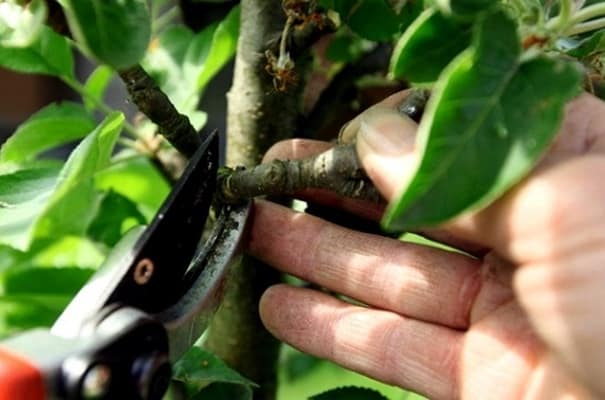

- a year later, all the weakened branches are cut off, and those that remain are shortened to 38 cm;
- in the fourth year, only weakened, damaged and dry branches need to be removed;
- in the fifth year, it is recommended to remove the top to limit growth (by this time, the height of the apple tree will be about 3 meters).
In the future, trimming is no longer necessary. Only dry, diseased branches are removed.
Cropping options
In the process of formation, either the side branches or the top are cut off. It is better to cut lateral branches in summer or spring. The procedure involves several stages:
- A year after planting, you need to cut off all the shoots, except for the top, leaving two buds.
- A year later, new shoots appear from the buds left. The branch that will grow vertically is cut again. Again, only two buds are left. Another branch, which grows more horizontally, is left to form the crop.
- In the following season, the horizontal branch from which the crop was harvested is completely removed.
- In the sixth year, the entire fruit branch is completely removed, since by this time it has exhausted all its resources.
See also
Description and features of the winter apple variety Lyubava, cultivation and productivityRead


Pruning of the crown shoot is carried out when it is frozen. The main task is to determine the strongest shoot that grows upright. It is he who will become the continuation of the main trunk. The rest of the shoots are removed according to the standard scheme.
By winter, a tree with cut branches must be insulated using a covering material.
Pruning apple trees at 2 years old
In the second year of apple growth, it is necessary to leave 3-5 sufficiently developed shoots, the rest is removed. The same pruning is repeated in subsequent years. When the apple tree reaches the desired and optimal height for you, a new growth of the central conductor is removed. Lateral crown-forming branches must be removed as soon as they grow to 40-50 cm. If necessary, overgrowing branches are cut out. With this type of pruning, the apple tree should take on a pyramidal shape.
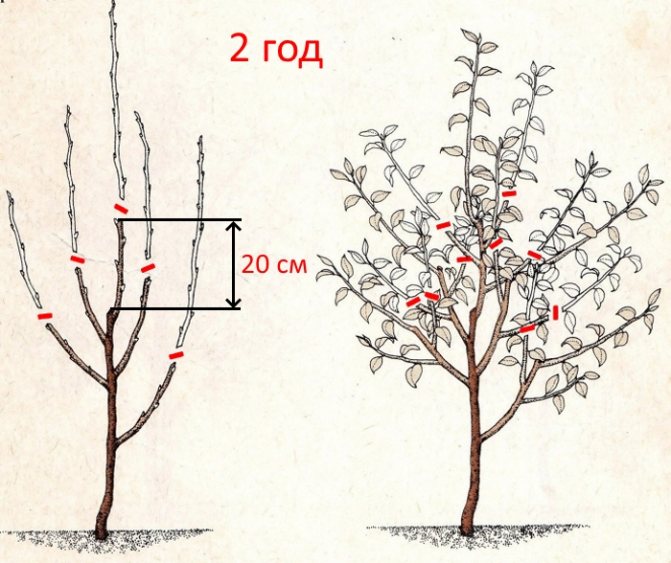

The center conductor is trimmed to the opposite kidney from last year's cut
Technique for performing the procedure
The weak point in a columnar apple tree is the top. For normal development, it is important to protect the apical kidney from adverse factors. During the period of spring formation, it is important to determine the strongest shoot, which is left for further development, and all the rest are removed.
To carry out the procedure correctly, it is important to observe the following recommendations:
- remove only young shoots that are not more than a year old;
- the cut is made in the direction from the base of the branch to the top;
- the cut is made 12 mm above the kidney;
- the incision is made neatly and evenly, taking care not to damage the bark.
You need to cut the branches carefully, taking care not to damage the bark. Do not make too deep cuts.
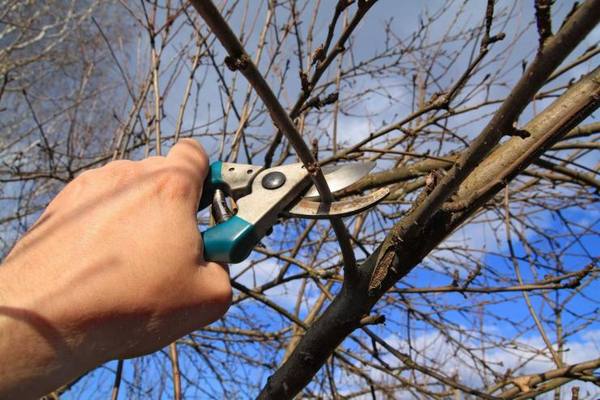

Winter pruning of apple trees
In winter, when there are no leaves on the tree, pruning is easier. All areas are visible, moreover, you can be sure that the tree is at rest. The main purpose of winter pruning is to bring the lower branches to the upper half of the tree. During winter formation, dry, weak and damaged branches are simultaneously cut, and a fruiting zone is formed.
The columnar apple tree has no permanent branches. Since their growth is cylindrical, the lower branches have not very favorable conditions for development. They receive little light and do not bear fruit. It is better to prune shoots on days when the air temperature does not drop below -10 degrees.
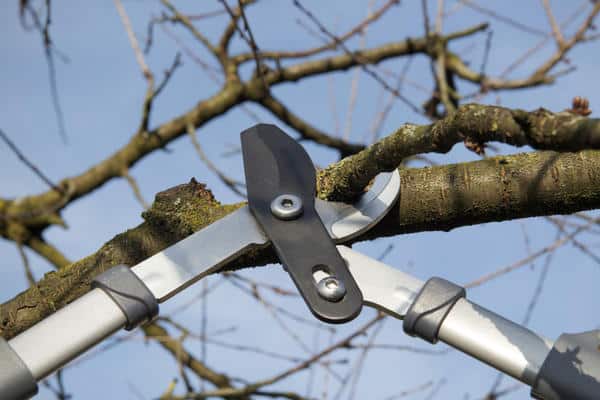

Spring
To activate the growth of the tree and the formation of the crown, spring pruning is carried out. The best period is the middle or last days of March. It is important to carry out the procedure before the start of the movement of the juice. Correct pruning involves leaving 4-5 buds on each branch.
After winter, the tips of the branches that are frozen are also removed. Pruning allows you to rejuvenate the tree and increase its resistance to adverse factors.
Summer
In the summer months, unnecessary shoots with leaves that grow from the main trunk are removed. They absorb nutrients and moisture, preventing branches from developing with fruits.
The branches of the columnar apple tree are easily removed by plucking. Small shoots should be removed with extreme care, since a tree tolerates one large wound better than several small ones.
Pruning semi-dwarf apple trees Russian spindle
There are several types of crowns for dwarf apple trees: "slender spindle", "flat spindle", "dwarf pyramid", "new Russian spindle". The last one on this list is the most popular.


Crown shaping scheme - flat spindle
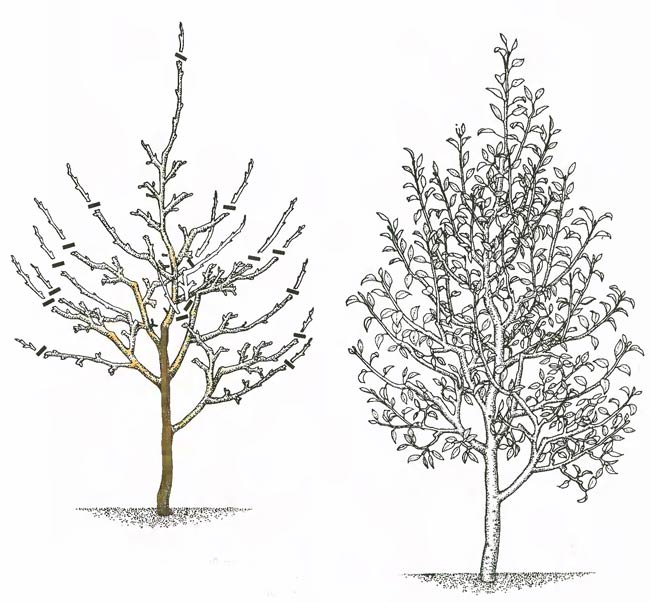

Crown formation scheme - dwarf pyramid
Crown shaping scheme - slender spindle
This formation was developed at the end of the 20th century for Russian conditions. The small leader shape of the crown in the form of a spindle allows for high yields. Grafting by budding on medium-sized rootstocks is carried out at a height of 10-15 cm, and on dwarf rootstocks - 5-10 cm. Skeletal branches are laid at a height of 0.6-1 m. The method of forming a "new spindle" is divided into three stages: conductor, skeletal branches and work with fruiting branches.The central conductor should be one, located strictly vertically, without branches. To form a crown, you need to use all the side branches, transferring them to a horizontal position with the help of small weights and spacers. Any side branch should be half as thin as the center conductor. In case of overgrowth, it is removed, leaving an oblique cut.
The lower semi-skeletal branches should have 3-5 weak lateral branches, 1-2 branches in the middle of the trunk, the upper ones are the weakest. After the lower branches have reached their maximum length, they must be shortened to a suitable lateral branch. Likewise, they deal with too drooping branches. Further, over the course of several years, it is necessary to repeat all the pruning and maintenance cycles on new tiers. They must be laid annually until the tree grows to a height of 3-3.5 m.At the same time, excessively thick branches (more than half the diameter of the main trunk) must be cut out in time on an oblique cut or transferred to a thin lateral branch.
Forming method
The cropping should be minimal, it essential for balancing plant growth and increasing yields. During the work, it is necessary to take into account the characteristics of such trees.
The main shoot is a kind of core, it cannot be shortened.
Shoots growing on the sides can be vertically and horizontally arranged branches. They are the basis for the creation of fruiting zones, which will bear fruit in the next 3-5 years.
With these intricacies in mind, proper pruning and proper care is extremely important.
- Removal - only part of the branch is cut;
- Tenderloin - One of the branches is cut completely.
Forming a columnar apple tree, proceed as follows:


A hedge of figuratively cut fruit trees.
- In the first year all lateral branches are cut into two buds. That allows you to make the shoots stronger, which in the future will give high-quality shoots;
- Next year it is necessary to remove horizontally located branches. They are cut off by an average of 30 cm. Vertical shoots located near the main stem do not touch, because the future harvest will grow on them;
- In the third year the works of the second season are repeated, they differ only in that they also remove the branches that bore fruit last year.
Read also Colds in the nose how to treat
If in doubt, whether to cut out one of the shoots, then you can use simple rule- shoots should not grow, in diameter reaching half the thickness of the tree trunk. This is how the columnar apple trees are formed.
Optimal timing for autumn pruning
The planted plant should root well and then you can start pruning the tree. Young seedlings should undergo so-called sanitary pruning. For its implementation, remove dry, damaged and extinct branches.
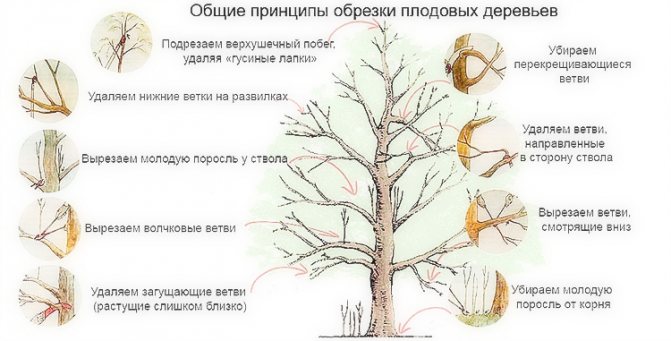

There are certain terms for pruning, which affect the period of acclimatization of the plant from the damage received and its further development.
Autumn pruning is carried out when all the leaves from the tree have fallen, but the temperature has not yet dropped below zero. During this period, the tree no longer forms a green mass. It rests after fruiting and pruning of branches will not injure the plant too much.
The procedure is started on a sunny day, when the weather is quite warm outside.
All work must be completed 2 weeks before the onset of stable frosts, so that the sections have time to tighten and the plant does not suffer.
It is important not to allow frost damage to the cut stems - they are the most vulnerable. Damaged areas will take a long time to overgrow, and some may even begin to rot. Therefore, it is so important to choose a suitable pruning period.
Mistakes of novice gardeners
The top is the most delicate part of the tree. In order for the trunk to develop and grow normally, it will be necessary to preserve the crown kidney. Its main enemy is frost - the main shoot damaged by the cold subsequently quickly thickens with young twigs, and the tree dies. Therefore, do not freeze the top and do not damage it during trimming. This material will tell you about the columnar pear of Decor.
In the spring, the gardener must accurately identify the strongest shoot and leave it for later development. The rest of the shoots are removed.
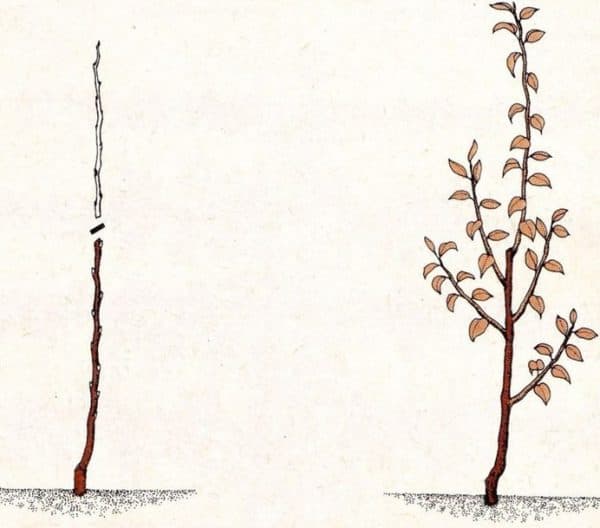

But even knowing the purpose and timing of trimming side shoots, you can harm the tree - if you ignore the technique of work.
The main mistakes made by inexperienced gardeners and their consequences:
- If after pruning a long stump remains, then in the future it will die off. Stubs that are too short interfere with the normal growth of the kidneys.
- Shaggy, oblique cuts cause bark injury. Make sure that the cut after trimming is flawless.
- During the formation of side branches, pruning is used for buds.
It is not so difficult to achieve an ideal cut - the main thing is to follow a number of rules. First, the work is done from the base to the top. Step back from the kidney by two fingers, cut straight, make sure there are no scuffs, burrs. Be sure to leave three buds on each shoot when pruning. The growth of branches in the future will depend on how strictly you follow these recommendations. For the procedure, use only well-sharpened special garden tools.
What is it for?
To get the classic "column", the apple tree needs help by cutting off the lateral shoots that will appear in the spring. Pruning will regulate their growth and form the correct columnar shape.
Pruning also has other benefits:
- even with a very dense planting, the branches of adjacent trees will not get confused;
- young branches will become stronger, and old ones will be replaced by new shoots;
- the slotted crown will receive more light and nourishment.
Compliance with all these factors will lead to a bountiful harvest.
The main feature of columnar apple trees is their weak growth. It is caused by an insufficient amount of growth hormones. The tree compensates for this deficiency by releasing a large number of flower buds that grow right on the trunk.
In order for the trunk to turn out to be strong and strong, capable of holding the maximum number of fruits, it is necessary to rid it of the lateral branches that weaken its formation. Trees are planted at a distance of 0.8-1 meters from each other, this is a fairly dense arrangement that requires certain conditions to be met.
Experienced gardening tips
Gardeners who are engaged in the cultivation of this type of apple trees give the following tips:
- trimming is done with a sharp tool, which can be soaked for several minutes in warm water before work;
- in winter, the snow that has fallen is scooped up to the trunk and on the ground near the trunk - in the cold it will protect the tree, and in the spring it will give the proper amount of melt water for the roots;
- when pruning, the most powerful escape is left - the gardener has to decide which one;
- the cut is made diagonally from bottom to top, in the opposite direction, from the kidney;
- when cutting, incorrect movements that injure the wood are not allowed;
- it is better to plant seedlings in the spring - they will have a long period in the warm season to take root, get stronger and then withstand the winter cold without harming the plant.
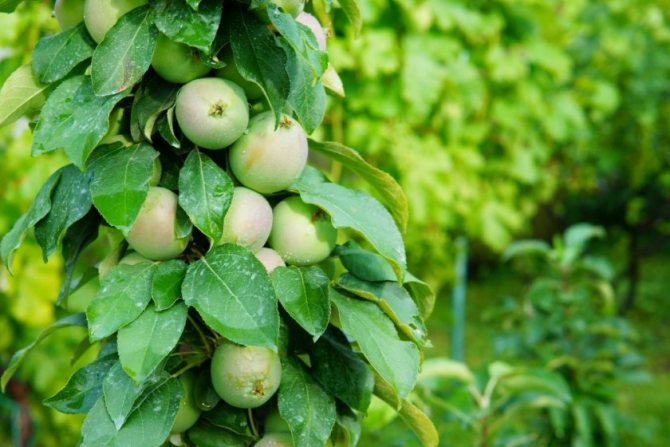

The columnar apple tree is an excellent garden decoration and a compact fruitful plant. The presence of only beds of these trees in the summer cottage will provide tasty fruits for 1-2 months of late summer and early autumn.
It just so happened that the apple tree in our gardens is the most traditional and most desirable tree. After all, it is not for nothing that it is believed that a few apples plucked straight from the tree and eaten right there on the spot can bring health to a person for a whole year. But in recent decades, household plots, especially near large cities, have become smaller and smaller.And it is becoming more and more difficult to place large fruit trees on them. But a traditional apple tree is a tree with a height of 6-8 meters and a crown diameter of sometimes up to 10 meters. It is not for nothing that industrial apple orchards observe the minimum distance between trees of 5-6 meters. But you want to have apple trees of different ripening periods in order to feast on tasty and healthy fruits from mid-summer to the very frost.
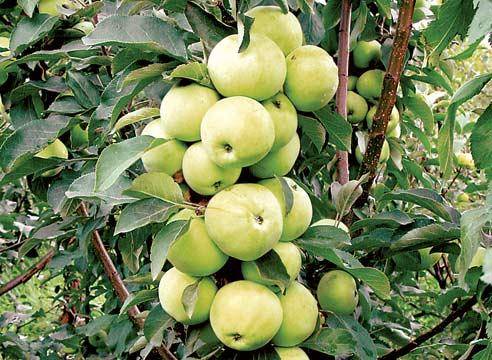

This is where the so-called columns come to the rescue, that is, columnar apple trees. It is believed that they take up little space, which means that even on a small plot of 2-3 acres, several trees can be placed at once and there will still be free space. And caring for them should not be difficult at all. But in reality, everything turns out not quite as we would like.
The maintenance and pruning of these trees is significantly different from traditional varieties. This article will be devoted to how to properly cut a columnar apple tree and take care of it.
Common pruning mistakes
Often, even with the correct procedure for pruning columnar apple trees, the result is not quite what is expected of it. The branches dry up, do not grow, the tree does not please with apples. The reason may be that the cuts themselves were not made quite correctly, because in such a difficult matter as pruning, there are no trifles.


In order not to repeat the most common mistakes, you only need to scrupulously follow a few rules:
- The cut should be performed from the base of the branch to its top.
- The direction of the cut should be opposite from the outermost kidney.
- The slice should be located 1.5-2 cm above the kidney.
- Finally, it should be perfectly flat, free from bark scuffs and burrs.
By following all these simple rules and adhering to the above schemes, you can achieve annual, rather abundant fruiting from your columnar apple trees, even in difficult Russian climatic conditions.
Thinning of fruits
As you know, a large number of fruits are tied in a low-growing apple tree. And this negatively affects the well-being of the tree, because, spending the reserves of nutrients to maintain the fruits, it is greatly depleted. And the quality of the fruits themselves also suffers: the color of the apple will be poor, insufficient, let alone the size. To avoid this, they carry out a saving thinning of the ovaries. After this procedure, only as many fruits are left as the tree can provide with decent nutrition. Such fruits will have excellent characteristics. And in the end result, you can get a good harvest of fairly high-quality and large fruits. And the growth of branches due to the redistribution of food will only increase annually. The complex and rational use of thinning with fertilization and skilled pruning will contribute to the healthy state of the dwarf apple tree, which will result in additional annual growth.
It is better to carry out thinning after the June fall of excess ovaries. Once that happens, know it's time to start thinning. First, shake each branch so that the loose ovaries fall off on their own. In the process of thinning, diseased, deformed or small fruits are also disposed of. Only healthy and best specimens are left.
After reading this article, you have learned how and why correct pruning is necessary. By limiting the growth of the crown, you allow the tree to concentrate its energy on the fruits, and the results will not be long in coming. Your apple stock will bear fruit and delight you.
Help for beginners
Pruning apple trees in the fall is not an easy task for beginners. A gardener with little experience can experience difficulties and also make mistakes.
IMPORTANT! It is impossible to cut an apple tree two or three years old strongly.
Here only weak forming or regulating pruning... If the branches of a young apple tree are significantly shortened, then the grown shoots will grow vertically, thickening the crown. The fruits on such an apple will be small, the yield will drop.
During the period of abundant fruiting, it is necessary replace the main fruiting branches every three to four years in the crown area.
Availability a large number of shoots in the central part not only thickens the crown, but also increases susceptibility to diseases and pests, reduces yield and quality of fruits.
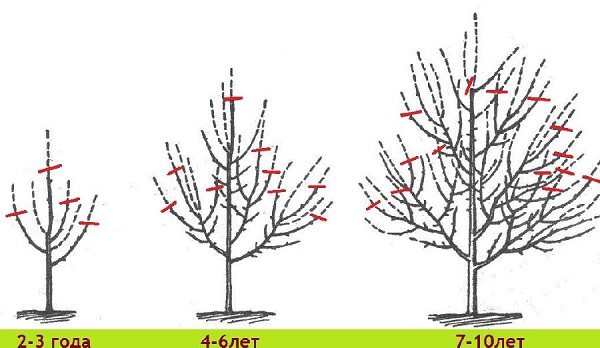

Scheme of pruning apple trees by year.
TIP! To make it easier to figure out which branches need to be removed or cut in the fall, you can use small multi-colored ribbons. Separately, we can highlight:
- Profusely fruiting branches;
- Branches with few apples or completely fruitless;
- Young shoots of this year.
In the fall, in this case, it will be easier to navigate the right choice: which branch to remove completely, which to shorten, which to free for better lighting.
You can find even more information on how to properly prune apple trees in the fall in this article.
Reasons for low yields


A sharp drop in yield indicates inadequate care.
Poor fruiting can be caused by several factors:
- Incorrect or untimely pruning.
- Excessive amount of nitrogen in the fertilizer.
- Stagnation of water in the substrate.
- The deformed position of the apple tree trunk.
- Thickened crown of a tree.
A fifteen-year-old tree has a drop in yield. Fruit trees should be replaced with young specimens.
How to thin out the crown to get large fruits?
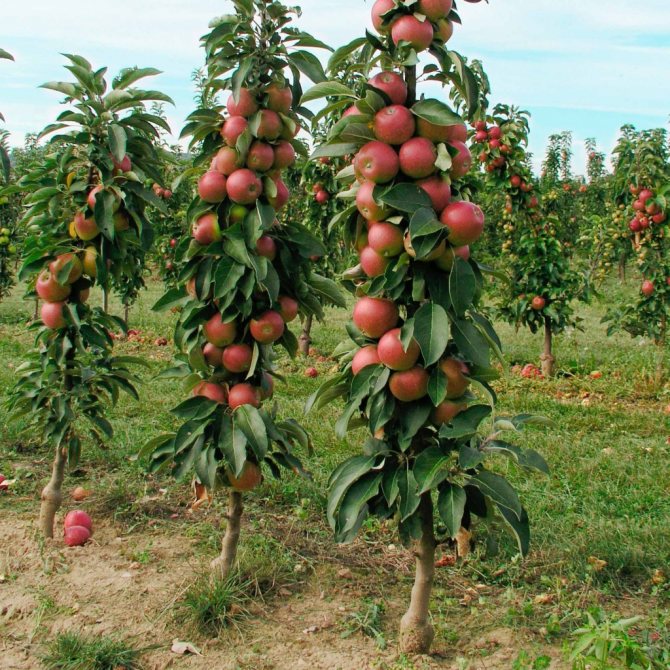

In order for the growth of branches, flowering and ripening of fruits to occur in an active mode, the aisles should have a width of no more than 1.5 meters. And the appearance of shoots should be constantly regulated. The uppermost stem bud should not be touched, it is needed for the growth of the seedling. The cut of the rest of the kidneys should be at an angle of 30 degrees, so that 3 cm remains to the kidney, the second from the trunk, in a year the kidneys will turn into full-fledged processes.
The next spring, do not touch the shoot that has grown close to the horizontal branch.
The more vertical one is cropped according to last year's pattern. Flowers will appear on a short horizontal branch, and 2 more processes will appear on the vertical branch. One will bear fruit, and the second will need to be pruned. According to this principle, the columnar apple should be pruned within 5 years. The saw cut must be lubricated with oil paint, garden pitch or clay.
Important! The top is cut off only when the upper shoot is frozen and started to release shoots.
There is another more complex way to form a crown. In addition to trimming, it also provides a pinch. If this method is applied to an ordinary apple tree, you can subsequently get a columnar from it. And vice versa, if a hybrid of a columnar apple tree is planted in the ground, having unnecessarily immersed the place of a dwarf rootstock in it, the upper part will give roots and turn into an ordinary tall apple tree.
The tree itself is a rootstock with a scion that has taken root in the nursery. Therefore, all major pruning should be done in the year of planting, without waiting for the seedling to take root. Then follow the annual pruning principle outlined above.
Pinching shoots
Pinching (pinching) is considered one of the important elements of pruning in the summer. It consists in removing non-lignified young shoots. It is better to carry out this procedure in the summer. Usually this manipulation is carried out by hand, pinching off part of the shoot (hence the second name), but sometimes they use a pruner if it is necessary to remove a large, main part of the shoot.They pinch young shoots only when buds wake up close to the leader branch, or when an unwanted shoot appears, which will contribute to the incorrect formation of the crown of your pet. Pinning of the newly formed shoots in the summer will allow you to avoid clipping on the ring with the onset of the next winter period. And only when the sprout becomes woody in the lower part, you can get rid of it with a pruner.
By pinching in the summer, you will help the tree retain nutrients and channel them into foliage growth and axillary bud growth and development. Each pinching is carried out in several stages. The best option would be 2-3 times within 7-10 days. After all, the growth of shoots is significantly different: the closer to the trunk (trunk), the weaker and vice versa.
If you started the first pinching with the onset of June, then the next one should be carried out in early July. If the third pinning is needed, then it will have to be carried out in August, but there is a risk. Young shoots may not have time to ripen and the winter cold will destroy them.
If pinching is done correctly, then the exuberant and active growth of developing young branches can be reduced. As a result, small and weak growth will be strengthened. Timely pinching has a significant effect on the growth and development of the tree. Remember, pinching is carried out until the shoot has stopped growing. In the event that the process has formed into a full-fledged apical bud, there is already a branch in front of you and pinching is not allowed to be applied to it.
Read also: Strawberry Mice Schindler - variety reviews, description, photo
Dates of the
Autumn pruning is carried out in November after the leaves have completely crumbled. In the spring, the procedure can also be done, but before the onset of swelling of the kidneys.
When freezing begins, the pruning is stopped. Do not ignore this moment - otherwise an open wound may form in the cut zone, which will begin to freeze and rot.
Autumn
- Old branches that have deteriorated, broken, need to be cut.
- Further, in the place of growth of a large number of small branches, the crown is thinned out, leaving the smoothest and strongest shoots.
- All painful, crooked branches extending at a slight angle from the trunk must be cut off (they still do not support the weight of the fruit during the harvest seasons).
- Remove tangled, rubbing branches, remove hemp on the ring.
- Carefully iron out the sections of branch cuts from irregularities and scuffs so that matinees do not injure the bast, then do the treatment with garden pitch.
- Wounds can be repaired with linseed oil or oil paint.
How to cover up a saw cut on an apple tree will tell this link.
At the end of the work, all the branches that have been cut are collected in one place and burned to ash.
Spring
In the spring, pruning of apple and currant varieties of Black Pearl, Sugar and other varieties is done before the buds swell. The areas of the cuts need to be processed, as in the fall, with a garden pitch. Shorten the shoots above the kidneys so that on one side of the edge of the medium it is at the level of the upper kidney part, and on the other, make a bevel to roll off the water.
In the spring, crown molding is continued, removing all frozen shoots. Do not forget about the crown - the lower, middle branches should be longer than the upper ones, and the top should be located above the crown. In dwarfs, only the tops are always removed. Read about the scheme for pruning columnar apple trees in spring in this material.

